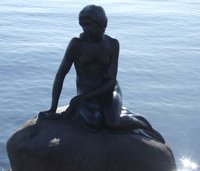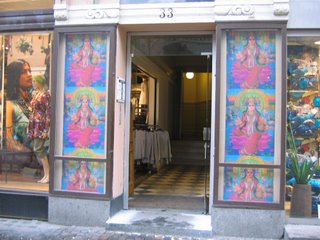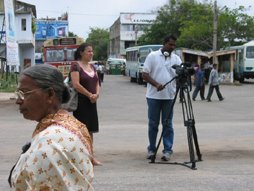Tsunami: “It took only few moments to shake the whole world”By Dushiyanthini Kanagasabapathipillai

"I feel guilty, that I could not save Arabi. I lost control and let her die. I am responsible for her death. I cannot forget her, because I loved her so much. I still can’t believe that she is dead. I carried her dead body from Mullaithivu to Mulliyawalai “says 13 years old Niranjala Balakrishnan and she burst into tears in Mullaitivu, North East of Sri Lanka, under the control of the Liberation Tigers of Tamil Eelam.
"Tender Sprout" was located in the coastal area of Mullaithivu, North East of Sri Lanka.
This home for the war orphans had 175 children when Tsunami hit, only 52 children survived;30 of them experienced the Tsunami and 22 children were with their relatives, since it was school vacation, when Tsunami hit.
They have accommodated more tsunami orphans recently.
There are 126 children living here and they want to accommodate more in the near future.
Although they are relocated to a different place inland, recent floods affected them once more.
Most of the children here are affected by the Tsunami.
Either they have lost their beloved brothers and sisters or struggled to survive.
They believe that, their beloved brothers and sisters who are still missing from the group will return home sooner or later.
They can't eat, sleep or play.
The cherished memories of the loved ones keep bothering these children.
They are unable to forget the past.
The lost loved ones stayed, ate, slept and played together.
They get up in the night and shout.
Mullaithivu was one of the worst affected areas by Tsunami.
"I was putting cover for the new exercise books, and getting ready for the new school term, which was supposed to begin in early January 2005. I heard a noise and everybody started to run. I also ran and climbed on a tree. I saw my little sister under that tree. And later she was washed away. I witnessed it. But I never saw her body. I was told that, she died on the way to the hospital" says 9 years old Susi Sinnathurai, who burst into tears.
There are more children, who do not know what has happened to their loved ones.
These little children are already affected by the two decades of ethnic conflict.
I was in London in December2004 undergoing training, when Tsunami roared Sri Lanka.
I had a very late night on 25th of December 2004, at my uncle's house in London, as we had a Christmas party.
I could not fall asleep at all, as I was thinking of traveling to Manchester to see my uncle and aunt who have come from Toronto to see their daughter.
I got up at 4am and had a shower.
I packed my bag, and got ready to catch the coach to Manchester, where my cousin lives. whom I have not seen for many years.
I was planning to be with her, and my uncle who came to Manchester from Toronto.
I made a cup of coffee.
And switched on the television, and watched BBC World.
Then I found out that Tsunami has hit Sri Lanka.
I immediately called my parents in Colombo to see whether they were keeping well
But the telephone lines to Sri Lanka were not easy to get through.
I informed my uncle and aunt that I have to return to Sri Lanka as soon as possible.
Then I have decided to cancel my trip to Manchester, and return to Sri Lanka.
I called my cousin and uncle to say that, "I am not coming to Manchester as I have planned".
They were not happy to hear that from me, but there was no other choice.
Then I called my good friend and former colleague Frances Harrison and explained what has happened in Sri Lanka.
She wasn't happy either.
And later my mobile was jammed.
I was unable to get through to anybody from my mobile or others couldn't get through to me on my mobile.
But I managed to send text messages to my colleagues.
And I have already started to make arrangements to my colleagues, who were rushing to Sri Lanka for news coverage.
Further I informed everybody that I am returning to Sri Lanka.
My uncle and his children came to the Heathrow airport to bid goodbye.
But my aunt couldn't come to the airport, as she was not feeling well.
I can still remember very well, that she advised me "Dushi I know that, you have taken risks in the past. But make sure that you take care of yourself, while being on the field and keep us informed how you are keeping".
I boarded the Emirates flight.
The President of Sri Lanka Chandrika Bandaranaike Kumaratunga flew on the same flight.
I called home and my sources from wherever and whenever possible to update myself.
And watched the television in the flight.
When I left London the death toll has already gone up to few thousands.
And it kept on increasing.
I arrived at the Katunayake International airport on 27th of December 2004 morning.
I went to the office straight to pick up some equipment.
I pulled out some hot weather friendly clothes from my bag, as I had all winter clothes to wear in London.
Although I was in Colombo, didn't have time to go to my house.
And went to the Ratmalana Domestic airport to catch a military flight.
The scheduled flight was cancelled due to the bad weather.
Managed to speak to the Sri Lankan Air force officers and got the permission to fly to Koggala Air Force Base in the South of Sri Lanka.
I flew with the military officers, who were dropped off at Peraliya, where the train accident took place.
I saw the devastation from the aerial view first, while flying to Koggala.
And I started to take photos, by using a small Canon, which produced enormous amount of unimaginable images from North, East and South of Sri Lanka later.
Landed at the Koggala Air Force Base at 6.30pm.
But there was no transport to go to Galle, South of Sri Lanka., because the roads were devastated.
I saw foreigners who were on holidays in the South, were queuing up at the Koggala Air Force Base to fly to Colombo as soon as possible.
Spoke to Air Force officers, and they provided a jeep to get myself dropped at Galle Light House Hotel, where my other colleagues were staying.
I traveled in the jeep, which had food parcels for the affected people.
But they have already started to spoil, as time flew by.
The road was deserted.
It took three hours to get to Galle from Koggala.
I went to the Light House Hotel in Galle at 12 midnight.
I had to start work immediately.
I went to the Karapitiya Base Hospital in the morning.
I witnessed dead bodies coming endlessly to the hospital.
The hospital morgue and corridors were full of dead bodies.
Most of the bodies were beyond identification.
Wailing relatives rushing to the hospital to identify their loved ones by their belongings such as rings, clothes, identity cards, and wrist watch.
I witnessed the mass burial in the South and in the North later.
The dead bodies were wrapped in polythene sheets.
The military was transporting the dead bodies from the sea shore to the hospital and burial place in the South.
But in the North the cadres of Liberation Tigers of Tamil Eelam cleared the area quicker than expected, disinfected the places, and transported the survivors to a safer place.
I saw nobody in Mullaitivu town, except the cadres who were carrying out their duties and dogs, which were searching for their owners.
And especially in the nights it was very disheartening to see a place, which was bustling after the Ceasefire Agreement signed between the then Government of Sri Lanka and the Liberation Tigers of Tamil Eelam in 2002.
Then I went to the Eastern province of Sri Lanka, where the most number of people killed by the Tsunami.
Witnessed the suffering by all three communities- Tamils, Muslims and Sinhalese.
There was no proper place to stay in the east, unlike other places in the country.
The roads were cut off by water.
I managed to find a guest house to stay in Kalmunai, East of Sri Lanka, which was affected as well.
There was no water to drink or bathe.
I used mineral water to bathe.
The owner of that guest house knows my dad very well, as he comes from the same place as my dad's.
Therefore he was extra hospitable to us.
As the shops were shut, he served us French fries, sausages and coca cola.
But I didn't have any appetite for food, because of what I have witnessed so far started to bother me so much.
Especially I witnessed in Kalmunai that the dogs have started to eat the dead human bodies which were unattended.
This was staggering to see.
I immediately informed the relevant authorities, but no action was taken.
As a Hindu, I even respect a dead body.
So I have decided to do a mass burial for five females, three males and three children –one male and two females.
My parents, brothers and relatives live in Sri Lanka and abroad kept calling me to keep them updated.
I requested all of them to send anything possible from edible to money to Sri Lanka as soon as possible to help the survivors.
They acted very promptly and quickly.
Some of have decided to sponsor Tsunami orphan through out the life time, widowers and men who lost their livelihoods.
And some of them lobbied in their countries and got long term monetary assistance for the tsunami affected victims in North, East and South of Sri Lanka, for which I really appreciate all the kind hearted human beings who extended their fullest co-operation to the survivors, without any hesitation.
Further, I have witnessed the suffering of the survivors from all three communities.
The people have become closer to my heart.
As I travel widely to the Tsunami hit areas very often people recognize me by my name, especially in the North, where I call my home always.
Most of them call me in Tamil "Amma"-Mother, "Magal"-Daughter, “Pillai” –Child, "Thangachchi"- Younger Sister, "Akka"- Elder Sister, "Monai" and "Nachchiyar", and share their heart breaking sad stories without any boundaries.
I still treasure those unforgettable and unhappy memories.
And I gathered new experiences in my decade long career, by covering the worst ever natural disaster- Tsunami, and the largest ever relief operation in the world. I had the opportunity of working with several world renowned Journalists.
On 26th of December 2004- boxing day, Tsunami- seven hours that shook the world, approximately 220,000 lives killed, so many million people made homeless and many of them still live in the temporary shelters.
In Sri Lanka about 38,000 people killed, 2, 34,000 affected and 1, 14,000 made homeless.
And most of the survivors still live in pain, while thinking about their lost loved ones.
There were two waves, the first was- a wave of killer, and the second was a wave of compassion.
"I loved my wife so much. We never had an argument. She was very affectionate. I miss her a lot. We were in the house, when tsunami hit. I survived, but I couldn't safe her. I feel guilty now. But it's too late. I don't know how to make a cup of tea even. That's how she took care of me. I can't forget the happy moments with her and remarry. I want to commit suicide. Because it's killing me day by day' says 56 years old fisherman Sundaramoorthy Sriskandarajah from Vannaankulam in Mullativu district, North East of Sri Lanka.
The Tsunami has made 80% of the men widowers in Mullaithivu district alone.
And most of their children, who survived the Tsunami, are living with their extended family members, as the fathers are unable to take care of them.
Twelve months have flown by since Tsunami, but the nightmares are never far behind them!
“The Tsunami was much destructive than two decades of civil war “the most of the survivors reiterated.
Most of their voices are still to be heard, by touching the peoples' lives with passion.
Please visit the following link to view more images of humanity
http://humanityashore.blogspot.com/



 They refer to the journalism that asks for people’s demands, desires and needs and how they are dealing with them.
They refer to the journalism that asks for people’s demands, desires and needs and how they are dealing with them. 
 "I feel guilty, that I could not save Arabi. I lost control and let her die. I am responsible for her death. I cannot forget her, because I loved her so much. I still can’t believe that she is dead. I carried her dead body from Mullaithivu to Mulliyawalai “says 13 years old Niranjala Balakrishnan and she burst into tears in Mullaitivu, North East of Sri Lanka, under the control of the Liberation Tigers of Tamil Eelam.
"I feel guilty, that I could not save Arabi. I lost control and let her die. I am responsible for her death. I cannot forget her, because I loved her so much. I still can’t believe that she is dead. I carried her dead body from Mullaithivu to Mulliyawalai “says 13 years old Niranjala Balakrishnan and she burst into tears in Mullaitivu, North East of Sri Lanka, under the control of the Liberation Tigers of Tamil Eelam.
